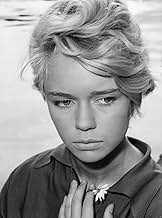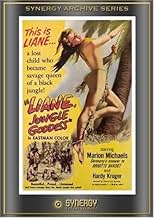Marion Michael(1940-2007)
- Actress
Marion Michael was born as Marion Ilonka Michaela Delonge in Königsberg, Germany (now Kaliningrad, Russia) in 1940. Her father was a doctor. The last months of the war she spent together with her mother and her four-year older brother on Hiddensee, a small island in the Baltic Sea. After the war, the family moved to Berlin where Marion attended a secondary school. As a ten-year-old, she made her stage debut in little theatre and was taught classical dance in the ballet school of Tatjana Gsovsky. When she was only 15, she was selected out of allegedly 12,000 entries for the lead in Liane, das Mädchen aus dem Urwald/Liane, Jungle Goddess (Eduard von Borsody, 1956). This adventure film was largely shot on location in Africa.
The story is about a girl who is discovered in the African jungle by an expedition group which includes Hardy Krüger. A tribe adores her as a goddess. It turns out that she is Liane, the long lost granddaughter of a rich shipowner in Hamburg. Her dark hair was dyed blonde and she was promoted as the 'German Brigitte Bardot'. Michael appeared topless during the first half of the film and this was part of the success of the film. However, she was acceptable for family audiences as the nature child with no obvious erotic suggestiveness.
The film was a huge box office hit, and producer Gero Wecker offered her a seven-year-contract. The press loved her, she was constantly photographed, and at the age of 18 she already owned a sports car. Unfortunately this success of her debut film would not be matched by any of her later films.
Marion Michael played next in the comedy Der tolle Bomberg/The Mad Bomberg (Rolf Thiele, 1957) opposite Hans Albers, an adaptation of the 1923 novel of the same title by Josef Winckler based on a real historical Westphalian aristocrat of the nineteenth century.
Then followed the sequel Liane, die weiße Sklavin/Jungle Girl and the Slaver (Hermann Leitner, 1957), this time opposite Adrian Hoven. Set in North Africa, this story concerns Arab slave traders who abduct Liane and members of her tribe. Later, the two Liane films were edited together and re-marketed as Liane - die Tochter des Dschungels/Liane - The Daughter of the Jungle.
In order to break away from the Liane image, Marion took dance and acting lessons and then appeared opposite Christian Wolff in Es war die erste Liebe/First Love (Fritz Stapenhorst, 1958) in which a Catholic theology student falls in love with a country girl. Tragedy came about when, during the shooting of the crime film Bomben auf Monte Carlo/Bombs on Monte Carlo (Georg Jacoby, 1960) with Eddie Constantine, she had a car accident that left her face temporarily scarred. However, she recovered and returned to acting in Schlußakkord/Festival (Wolfgang Liebeneiner, 1960), the Schlagerfilm Davon träumen alle Mädchen/That's What All The Girls Dream About (Thomas Engel, 1961), and Jack und Jenny/Jack and Jenny (Victor Vicas, 1963) with Senta Berger and Ivan Desny.
The following decade, Marion Michael mainly worked for love theatre and television. For six years she worked at the Städtischen Bühnen Köln and In 1970 gave birth to a son, Benjamin, allegedly fathered by an American director, with whom she lived in a commune and with whom she also did some street theatre. Afterwards, she suffered severe depression after a short marriage to actor Marcel Werner ended, and retired from acting in 1976. For a while she then worked as a saleswoman. In 1979 she took the unusual step of moving from West to East Germany, where she worked as a synchronisation assistant for TV.
She still occasionally acted in TV-films such as In Hassliebe Lola/In Hate Love Lola (Lothar Lambert, 1995) and Blond bis aufs Blut/Blonde Till Blood (Lothar Lambert, 1997), and in 1996 her life became the topic of a TV musical, Liane (Horst Königstein, 1996). She also played a small role in the production. The film was nominated for the Adolf Grimme award and the Prix Europa 1997.
In her later years, she still remained a well known German film icon and with her second husband, Freimut Patzner, lived in an old house in Oderbruch. In 2007 Marion Michael died of heart failure in a hospital in Gartz an der Oder. It was four days before her 67th birthday.
The story is about a girl who is discovered in the African jungle by an expedition group which includes Hardy Krüger. A tribe adores her as a goddess. It turns out that she is Liane, the long lost granddaughter of a rich shipowner in Hamburg. Her dark hair was dyed blonde and she was promoted as the 'German Brigitte Bardot'. Michael appeared topless during the first half of the film and this was part of the success of the film. However, she was acceptable for family audiences as the nature child with no obvious erotic suggestiveness.
The film was a huge box office hit, and producer Gero Wecker offered her a seven-year-contract. The press loved her, she was constantly photographed, and at the age of 18 she already owned a sports car. Unfortunately this success of her debut film would not be matched by any of her later films.
Marion Michael played next in the comedy Der tolle Bomberg/The Mad Bomberg (Rolf Thiele, 1957) opposite Hans Albers, an adaptation of the 1923 novel of the same title by Josef Winckler based on a real historical Westphalian aristocrat of the nineteenth century.
Then followed the sequel Liane, die weiße Sklavin/Jungle Girl and the Slaver (Hermann Leitner, 1957), this time opposite Adrian Hoven. Set in North Africa, this story concerns Arab slave traders who abduct Liane and members of her tribe. Later, the two Liane films were edited together and re-marketed as Liane - die Tochter des Dschungels/Liane - The Daughter of the Jungle.
In order to break away from the Liane image, Marion took dance and acting lessons and then appeared opposite Christian Wolff in Es war die erste Liebe/First Love (Fritz Stapenhorst, 1958) in which a Catholic theology student falls in love with a country girl. Tragedy came about when, during the shooting of the crime film Bomben auf Monte Carlo/Bombs on Monte Carlo (Georg Jacoby, 1960) with Eddie Constantine, she had a car accident that left her face temporarily scarred. However, she recovered and returned to acting in Schlußakkord/Festival (Wolfgang Liebeneiner, 1960), the Schlagerfilm Davon träumen alle Mädchen/That's What All The Girls Dream About (Thomas Engel, 1961), and Jack und Jenny/Jack and Jenny (Victor Vicas, 1963) with Senta Berger and Ivan Desny.
The following decade, Marion Michael mainly worked for love theatre and television. For six years she worked at the Städtischen Bühnen Köln and In 1970 gave birth to a son, Benjamin, allegedly fathered by an American director, with whom she lived in a commune and with whom she also did some street theatre. Afterwards, she suffered severe depression after a short marriage to actor Marcel Werner ended, and retired from acting in 1976. For a while she then worked as a saleswoman. In 1979 she took the unusual step of moving from West to East Germany, where she worked as a synchronisation assistant for TV.
She still occasionally acted in TV-films such as In Hassliebe Lola/In Hate Love Lola (Lothar Lambert, 1995) and Blond bis aufs Blut/Blonde Till Blood (Lothar Lambert, 1997), and in 1996 her life became the topic of a TV musical, Liane (Horst Königstein, 1996). She also played a small role in the production. The film was nominated for the Adolf Grimme award and the Prix Europa 1997.
In her later years, she still remained a well known German film icon and with her second husband, Freimut Patzner, lived in an old house in Oderbruch. In 2007 Marion Michael died of heart failure in a hospital in Gartz an der Oder. It was four days before her 67th birthday.






















